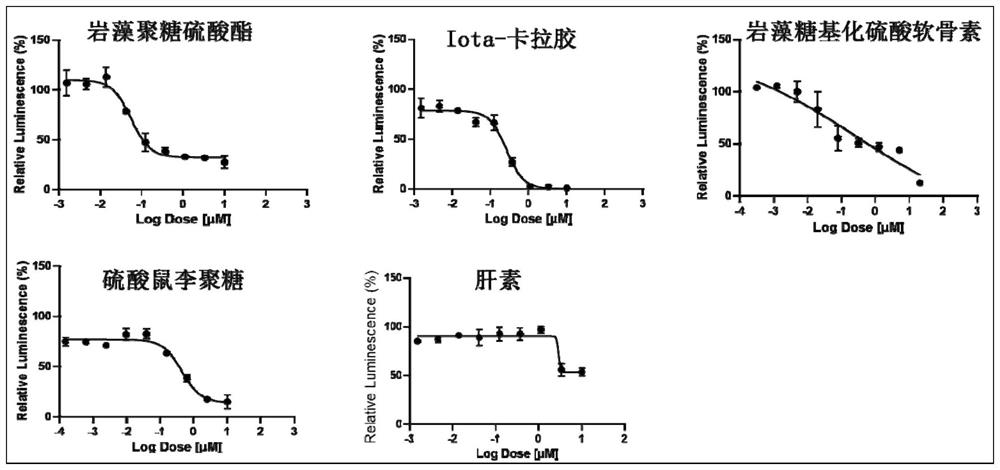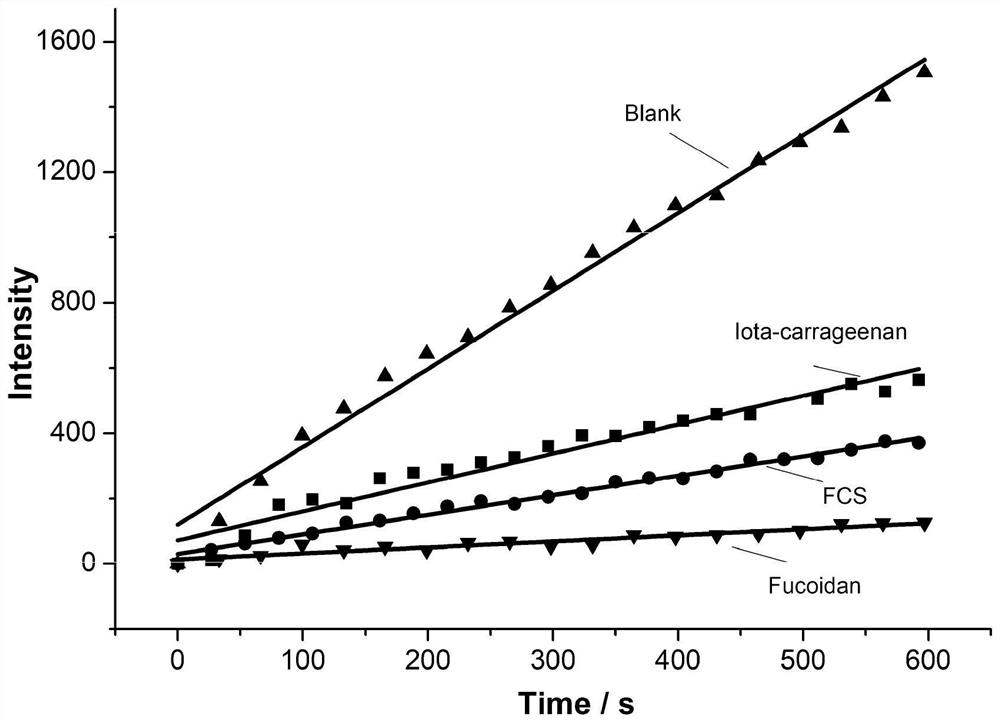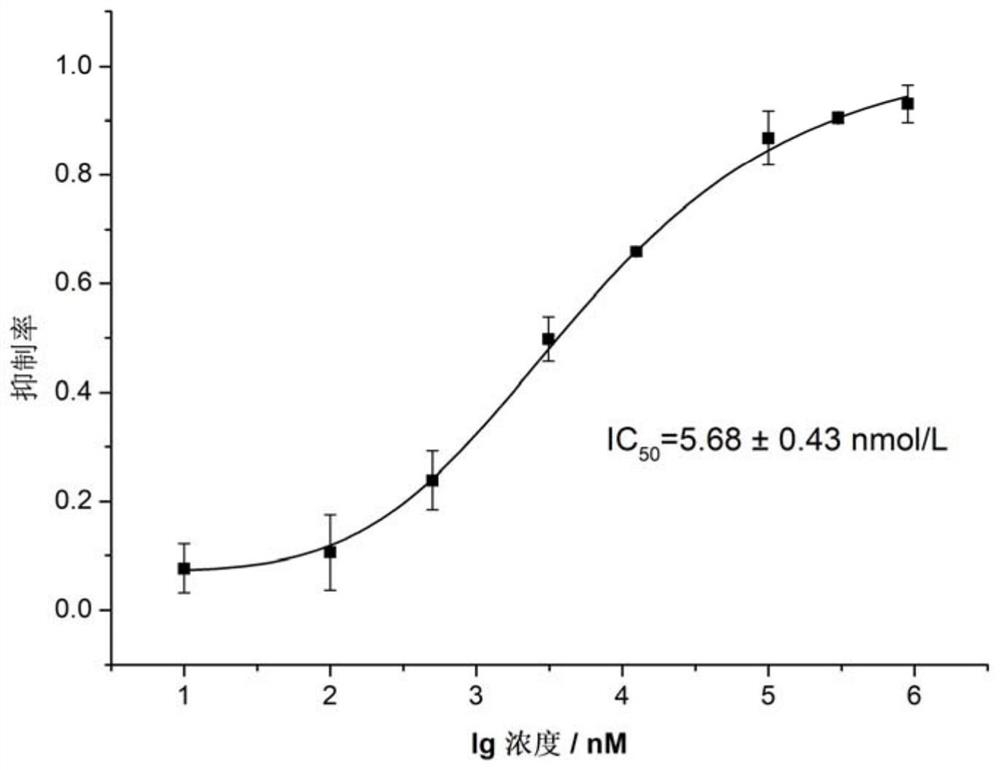Application of natural sulfated polysaccharide derived from marine organisms as drug for resisting coronavirus and induced diseases
A sulfated polysaccharide and coronavirus technology, applied in the field of biomedicine, can solve the problem of undiscovered anti-new coronavirus activity
- Summary
- Abstract
- Description
- Claims
- Application Information
AI Technical Summary
Benefits of technology
Problems solved by technology
Method used
Image
Examples
Embodiment 1
[0087] Example 1 The inhibitory effect of natural sulfated polysaccharides from marine organisms on SARS-CoV-2 spike protein
[0088] Based on the SARS-CoV-2-spike protein virus detection system, evaluate fucoidan sulfate (derived from brown algae), iota-carrageenan (derived from red algae), fucosylated chondroitin sulfate (derived from Sea cucumber), rhamnosan sulfate (derived from green algae) block the effect of SARS-CoV-2 infected cells.
[0089] The sulfated polysaccharide sample used in the present invention can be extracted by conventional reagents, methods and equipment in the technical field.
[0090] 1) Cell resuscitation culture: 293T / 17 human embryonic kidney cell line, calculated by weight percentage, was cultured by mixing 10% fetal bovine serum, 1% double antibody and the rest of DMEM medium, and cultured for two generations after resuscitation. .
[0091] 2) Viroid preparation: spread 293T / 17 human embryonic kidney cells in a 6-well cell culture plate, and wh...
Embodiment 2
[0100] Example 2 Inhibitory effect of natural sulfated polysaccharides from marine sources on SARS-CoV-2 main protease
[0101] The main protease of SARS-CoV-2 can hydrolyze the fluorescent polypeptide substrate to make the substrate fluorescent. The main protease activity was inhibited by natural sulfated polysaccharides from marine sources, and the fluorescence intensity was lower than that of the blank control. Among them, the main protease and the fluorescent polypeptide substrate can be obtained by the method reported in the literature W.Dai et al., Science 10.1126 / science.abb4489 (2020).
[0102] (1) Preparation of TE buffer solution
[0103] Add 100 μL of 0.5 M ethylenediaminetetraacetic acid disodium (EDTA-2Na) aqueous solution into 2.5 mL of 1 M Tris-HCl buffer solution, dilute to 50 mL, adjust the pH to 7.3, and filter through a 0.22 μm filter membrane Afterwards, store at -4°C.
[0104] (2) Screening of the inhibitory activity of sulfated polysaccharides from mar...
Embodiment 3
[0113] Example 3 Inhibition of Fucoidan Sulfate of Different Concentrations on SARS-CoV-2 Main Protease
[0114] (1) Inhibition experiment of fucoidan sulfate on main protease activity
[0115] Add 87 μL TE buffer solution to the 96-well cell culture plate, then add 1 μL main protease with a molar concentration of 19.7 μM, mix well, and add 2 μL H 2 O and nine seaweed-derived fucoidan sulfate aqueous solutions with a molar concentration ranging from 0.5nM to 45μM were added to each well in turn, shaken well, and after reacting at room temperature for 30min, 10μL of 20μM molar concentration was added to each well. Substrate, quickly use a microplate reader to detect the fluorescence intensity. The sulfated polysaccharide sample used in the present invention can be extracted by conventional reagents, methods and equipment in the technical field.
[0116] (2) Microplate reader detection conditions
[0117] Under the conditions of excitation wavelength 320nm, emission wavelengt...
PUM
| Property | Measurement | Unit |
|---|---|---|
| Molecular weight | aaaaa | aaaaa |
Abstract
Description
Claims
Application Information
 Login to View More
Login to View More - R&D
- Intellectual Property
- Life Sciences
- Materials
- Tech Scout
- Unparalleled Data Quality
- Higher Quality Content
- 60% Fewer Hallucinations
Browse by: Latest US Patents, China's latest patents, Technical Efficacy Thesaurus, Application Domain, Technology Topic, Popular Technical Reports.
© 2025 PatSnap. All rights reserved.Legal|Privacy policy|Modern Slavery Act Transparency Statement|Sitemap|About US| Contact US: help@patsnap.com



